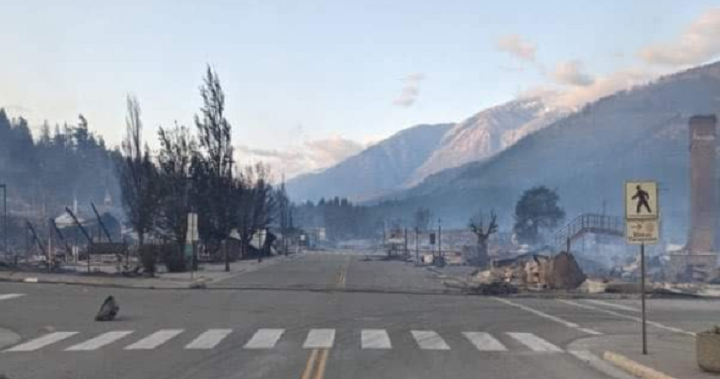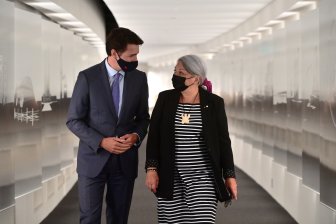The B.C. wildfires that destroyed the small community of Lytton amid a record heatwave could have ripples effects on home insurance across the country, experts say.
While homeowner and commercial policies typically include protection against wildfires, the worry is about the potential impact on the future availability and cost of coverage in the future.
“I am concerned going forward,” Lytton mayor Jan Polderman said.
Even before the devastating fire that tore through the village last week, insurance had become getting harder to get for businesses, Polderman told Global News, recalling a recent conversation with a local company that had to forego insurance for the first time this year.
Read more:
What Australia’s fires could mean for insurance and real estate in Canada
As climate change increases the frequency and intensity of wildfires, insurance has become a familiar headache for communities in fire-prone areas. While officials suspect human causes for the inferno that burned about 90 per cent of Lytton last week and killed two people, there is little doubt that record-breaking temperatures and dry weather had created tinderbox-like conditions in the area.
B.C. has so far seen 722 wildfires during the current fiscal year, which begins on April 1. According to provincial records, the fires have burned 91,966 hectares of land, more than twice the area affected by fires in 2019 and 2020 combined.
And “as risk increases, (insurance) premiums will increase,” says Blair Feltmate, head of the Intact Centre on Climate Adaptation at the University of Waterloo.

Canada: ‘A riskier place for insurers to do business’
Most of the work on the relationship between extreme weather events linked to climate change and home insurance premium is about flooding, Feltmate says. Over the past five years, home insurance premiums have increased by about 20 to 25 per cent, with 60 percent of that increase is due to residential flooding, he adds.
At the same time, coverage limits have also decreased, he notes. And from Eastern to Western Canada, a growing number of homes have become de facto uninsurable due to the risk of flooding, with premiums so high they’re unaffordable for most people, Felmate says.
When it comes to risk from wildfires, premium increases may follow a similar trajectory, he warns.
Canada is, on average, warming at about double the global rate, with Northern Canada continuing to warm even faster, according to a 2019 government report.
“It’s a riskier place for insurers to do business,” says Craig Stewart, vice president of federal affairs at the Insurance Bureau of Canada (IBC).
Read more:
Western Canada’s extreme heat wave: Some experts have ‘never seen’ anything like it
Those who, based on updated risk modelling, are living in areas prone to flooding, fire or other extreme events are likely to see the steepest premium increases, he says. But insurance risk linked to climate change can be “widespread,” he says.
“We can all be feeling it in our pocketbooks.”

And increased risk tied to climate change can also affect the supply of insurance available given market, he adds. As insurers weigh their risk exposure globally, they may pull out of some particularly risk markets, which can result in decreased competition, higher prices and less choice for both homeowners and businesses needing insurance, Stewart says. Sometimes, it can result in insurance simply being unavailable in certain areas.
That’s become a well-known issue for some homeowners in California, where a string of catastrophic fires has resulted in record liability for insurers. Insurance providers lost a total of $20 billion in 2017 and 2018, wiping out the profits of the past 26 years and leaving the industry with an aggregate loss of $10 billion, according to research by financial consulting firm Milliman.
Insurers started pulling out of select local markets, cancelling or refusing to renew the policies of tens of thousands of homeowners deemed to be at too high risk. In December 2019, the state issued an order temporarily barring insurers from dropping policyholders in areas affected by recent wildfires. The government has since renewed and extended the scope of the ban in November 2020.
Read more:
First your home is flooded — then you lose your mortgage?
Still, in areas where insurance is unavailable — or only available at unaffordable rates — local economies are taking a hit. In Napa Valley, for example, winemakers and farmers left without insurance are wondering whether they can continue to do business at all.
When it comes to insurance for homeowners, B.C. does not face California’s predicament, according to IBC’s Stewart.
“We are not seeing any changes in an insurance supply,” he says. “Unlike California, it’s a very competitive market across the country — there are lots and lots of options for home protection.”
Even the Fort McMurray fire of 2016, with $3.7 billion insured losses, was the most expensive event for insurers in modern Canadian history, did not shake the industry.
On the commercial side, on the other hand, there are fewer providers across the country, according to Stewart.
“It’s been difficult for the last two years to get commercial insurance coverage,” he says, although he adds the situation is expected to improve.

What homeowners can do to contain wildfire risk and their insurance premiums
The glass-half-full perspective for homeowners in hard-hit areas is that simple precautions and relatively inexpensive property upgrades can significantly mitigate the risk from wildfires.
Using fire-resistant materials for a home’s roof and cladding as well as for the back porch and any fences, for example, significantly reduces the chances that the structure will ignite.
Just what a difference building materials can make became strikingly clear in the Fort McMurray fire, during which certain homes were spared even as neighbouring properties burned to the ground, Stewart said.
“It had everything to do with when embers are flying through the air and they land on a roof,” he says. “Is that roof made of metal or is it made of asphalt? If it’s asphalt, that home is going to burn.”
Other precautions include keeping an area of at least two meters around the perimeter of the house clear of any vegetation or shrubbery that could catch fire, Feltmate says. It’s also a good idea to avoid storing wood for wood burning against the house’s exterior walls, he adds.
In general, homeowners can turn to Canada’s FireSmart principles to minimize their properties’ vulnerability to fires, Feltmate notes. Doing so will also help contain their insurance premiums, he adds.

Many insurers in Canada endorse the idea of rebuilding homes affected by wildfires to higher standards that mitigate risk from a future blaze, Stewart says. The good news, he adds, is that much of what can be done to make homes less prone to burn down is relatively inexpensive.
“It really comes down to a conversation with the individual insurer about how that happens,” he says.
Local authorities can also take steps to protect communities from fire, Feltmate says. Just like clearing a home’s perimeter of vegetation helps reduce the chance that the property will catch fire, so does a barren “exclusion area” around a town or neighbourhood decrease the probability that the flames will travel from the woods to the community.
“Is it a perfect is it a perfect solution? The answer is no. Is it better than not doing it? The answer is yes,” Feltmate says.
Those who would rather relocate than rebuild in the same fire-torn area may be able to get a payout from their insurer, Stewart says. While only some policies allow this, some homeowners have the latitude to rebuild in a different location, he adds.
Still, unlike with homes located in floodplains, where homeowners may have little alternative but to move, protecting those living in fire-prone areas is more about of building back better, Stewart says.
“It is about being smarter.”
© 2021 Global News, a division of Corus Entertainment Inc.
















































